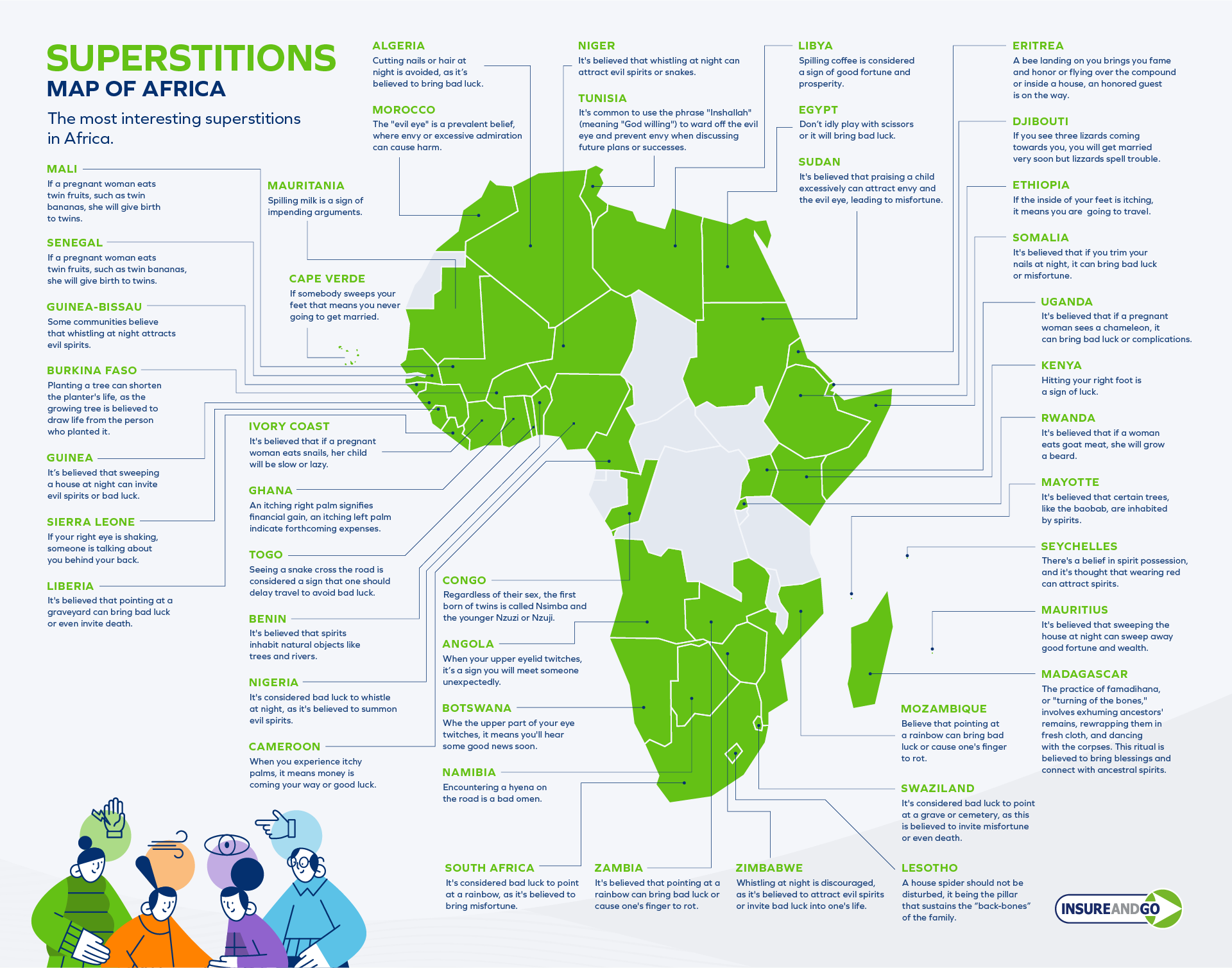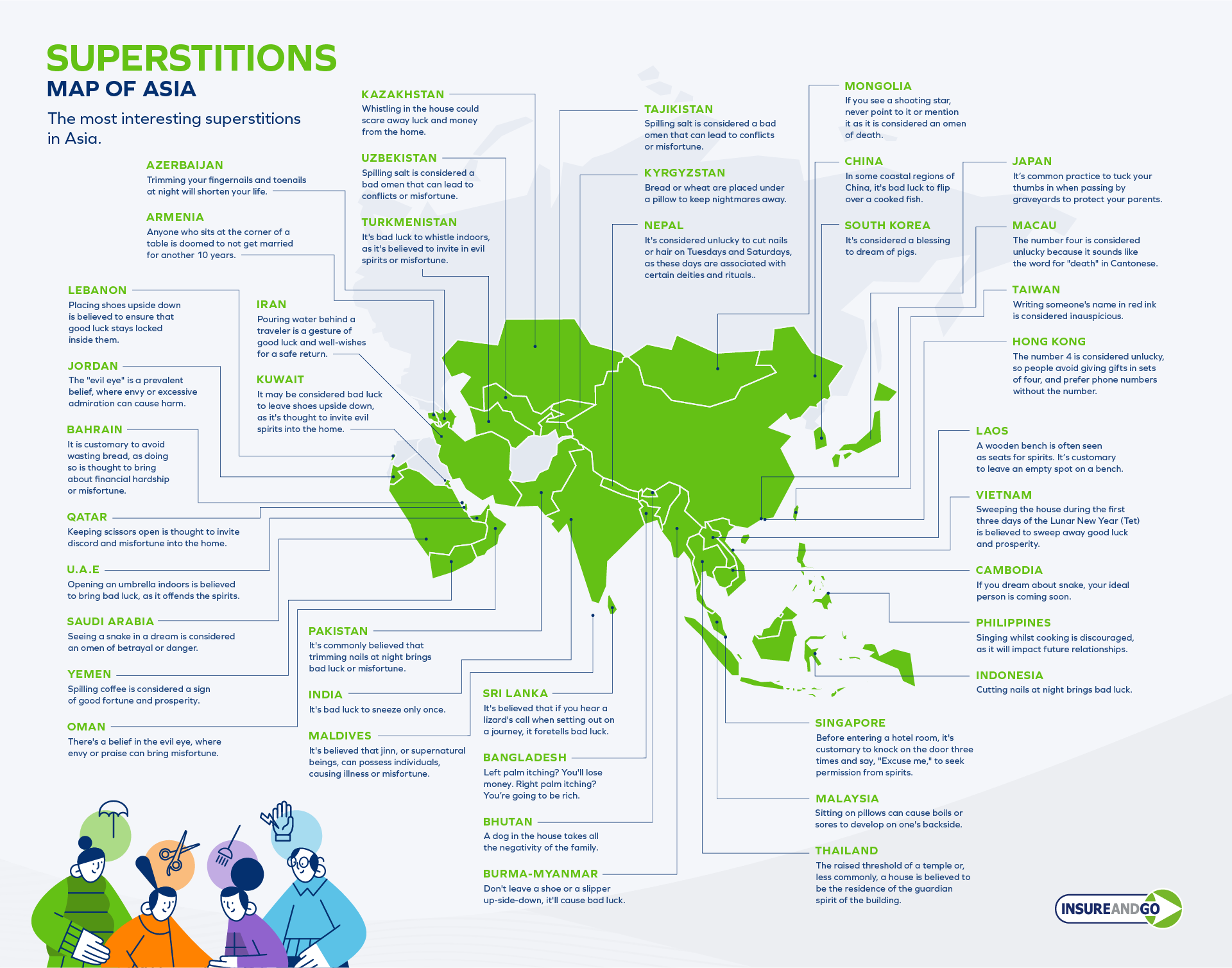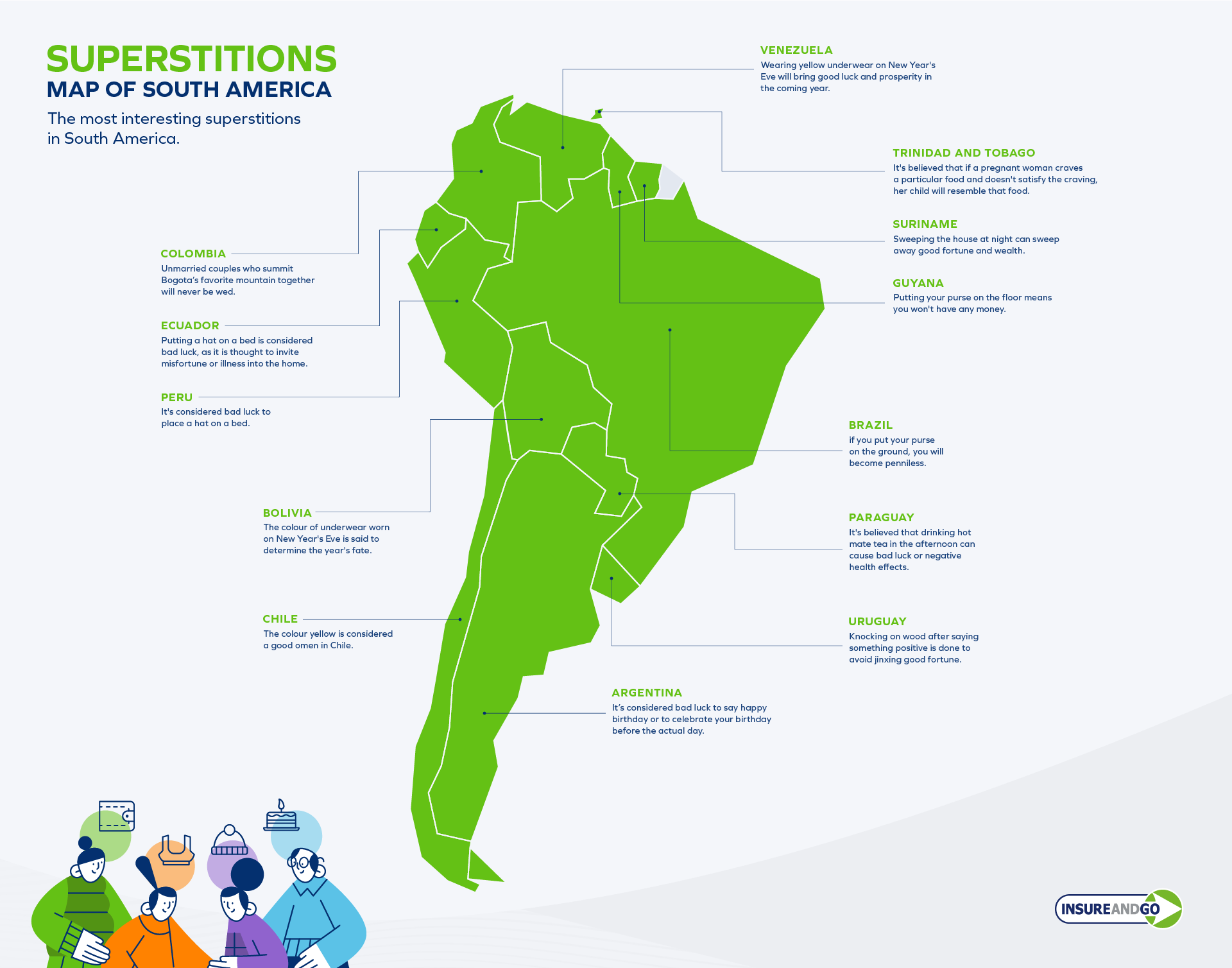Whether it’s a lucky pair of pants or an aversion to Friday the 13th, superstitions have long fascinated people around the world. Some are more well-known than others, but superstitions have been a part of different cultures for centuries, and many of us hold on to one or two throughout our lives.
Tossing salt over your shoulder or avoiding the number 13 might give some people peace of mind, but they can’t always be guaranteed to counteract bad luck. For travellers heading abroad, the best way to protect yourself is to buy comprehensive travel insurance to safeguard against the unexpected.
That said, learning about local superstitions is a wise move when travelling. It’s not just about avoiding bad luck (or inviting good luck!) but also about showing respect for local traditions and customs. With this in mind, we’ve dived into the data, analysing Google search results for ‘superstitions in [country]’ in over 220 countries to uncover the most unique beliefs around the world, creating a handy resource for anyone planning to explore a new culture this year.
Every country’s most interesting superstition

Besides familiar superstitions like knocking on wood or crossing your fingers, our global map showcases the sheer variety of unique superstitions that are embedded in cultures across the world. Despite their diversity, many superstitions share common themes, around wishing for good fortune, or warding off bad luck. From animals as symbols of influence, to numbers carrying significance, and even patterns like spirals believed to bring good fortune, humans all share similar hopes and concerns in our everyday lives.
Whether it’s the belief that itchy hands predict incoming money across African nations or the tradition of wearing specific-coloured underwear to shape your future in South America, read on to discover how superstitions vary across continents.
Superstitions in Europe

Looking at Europe, a lot of the superstitions are related to rituals believed to bring good luck or actions which prevent misfortune, such as avoiding spilling salt or breaking mirrors. Some more interesting superstitions involve natural events, such as falling leaves or the Aurora Borealis. In Iceland, for example, waving at the Aurora Borealis is said to invite bad luck or even physical harm. Further east, in Slovenia, holding a button when seeing a chimney sweeper is believed to bring good luck, whereas eating raw sliced garlic mixed with yoghurt is thought to bring good luck in Austria.
Another food-related superstition can be found in Italy, where placing bread upside down is considered a sign of bad luck. Meanwhile in the UK, some people believe that if you catch a falling leaf in autumn and keep it safe until the first signs of spring, it is said to bring good luck for the months that follow and even prevent you from catching a cold in winter!
Superstitions across Oceania

Common superstitions across Oceania are often related to spirits and the supernatural, as many cultures strongly believe in ancestral ghosts and supernatural forces. Objects, stones, or natural sites are typically thought to house spirits, requiring respect and rituals to avoid misfortune. There is also a huge emphasis on respecting nature, as many believe disrupting it without proper rituals invites bad luck and specific animals are linked to ancestral spirits or omens.
For example, in Fiji, butterflies flying near you are considered a visitation from a deceased loved one, while in Tokelau, certain fishing areas are considered sacred, and fishing in these zones is believed to bring bad luck or anger ancestral spirits. Many Australians believe that on the first day of the month, your first word should be “White rabbits” to bring good luck.
Superstitions in Africa

African nations have a variety of superstitions, with many of them involving spirits, ancestors, and rituals.
For example, a common superstition among the people of the Congo is the firstborn twin is believed to have spiritual powers, while the second twin is associated with managing legal affairs. Nigerians tend to avoid whistling at night, as it’s believed to summon evil spirits, while in South Africa pointing at a rainbow is thought to cause bad luck.
Some other African superstitions are related to nature and animals, such as in Togo, where many believe seeing a snake cross the road means delaying your travels to avoid bad luck, while Namibians believe Hyenas crossing the road is a bad omen.
Any singles from Cape Verde looking to get married should avoid stepping on their own feet, as it’s believed that if you do you won’t get married, whereas in Senegal, it’s a common belief that sweeping someone’s feet with a broom could also harm their marital prospects.
Superstitions in Asia

On the Asian continent, several countries share similar or identical superstitions, often influenced by cultural, historical, or geographical connections.
A common superstition in South Asia, in countries such as India and Pakistan, is that cutting your nails at night is linked to misfortune and bad luck, while countries in the Middle East, such as Jordan and Oman, share an interesting superstition about the “evil eye”. The evil eye is a belief that envy, or excessive admiration, can cause harm to a person, their health, or their possessions.
People from Tajikistan and Uzbekistan believe that spilling salt will lead to conflict or misfortune unless a ritual, such as throwing a pinch of salt over the left shoulder, is performed, and in Cambodia, dreaming of a snake indicates a romantic person will come into your life. At the same time, over in Bahrain, the same superstition has a more negative twist, as it’s believed that dreaming of snakes is linked to betrayal or danger.
Although, the number 13 is considered an unlucky number in many cultures, in Asia several countries consider the number four as unlucky instead. For example, in Macau, the number four is avoided as it sounds like “death” in Cantonese. The same occurs in Hong Kong where the number four is considered such a bad omen that people even try to avoid gifting anything in sets of four.
Superstitions in the US

Over in the United States, a huge variety of superstitions can be found across all 50 states. In general, common themes for the whole of the US are primarily good luck, misfortune, bad omens, as well as spiritual and ghostly associations.
Taking a deeper look at the different regions, some patterns do occur. For example, superstitions in the South and Southeast tend to focus on wealth and prosperity, such as in Louisiana, where many believe that never eating both ends of a loaf of bread will keep the money flowing, and in Georgia, where there’s a common belief that when a ladybug lands on you, it is a sign of good luck and fortune.
The superstitions in the Northeast states of the US focus mostly on luck and protection. In Maine, for example, many paint their porch blue as it’s believed to keep witches away, a common tradition in coastal areas, and in the state of New Hampshire, government buildings don’t include the seat number “13” as it’s considered bad luck.
In the Midwest of the US, many superstitions have been influenced by the farming and mining industry. For example, in Minnesota, killing rats in mines is considered bad luck because they are believed to sense danger, while in Tennessee, many believe carrying a piece of coal fights curses.
Looking at the Western States, common superstitions have a mix of attracting good fortune or warding off bad luck. In Montana, many believe that bad luck comes in threes, meaning that people often prepare for a third tragedy after two misfortunes. Whereas in the state of Wyoming, giving someone a knife without them “paying” for it severs the relationship, which is likely tied to the ranching culture and the importance of tools.
Superstitions in South America

Similarly to many North and Central American countries, some of the more interesting and popular superstitions across South America relate to marriage and colour symbolism.
For the same reason, people in Honduras, Haiti, and Nicaragua avoid sweeping someone’s feet, unmarried couples in Colombia avoid climbing the summit of Bogotá’s most popular mountain, Monserrat, as it’s believed they will never make it to the altar otherwise.
In Bolivia, the colour you wear on New Year’s Eve is believed to determine your year’s fate: red underwear means you will attract love; gold is thought to bring wealth and prosperity, and white underwear promotes peace and harmony. Venezuelans tend to wear yellow underwear on New Year’s Eve, as it’s believed to bring good luck and prosperity in the coming year.
Another fascinating superstition can be found in Argentina, where people avoid saying happy birthday before the actual day as it’s considered a bad omen, while people in Uruguay believe that knocking on wood after saying something positive will avoid jinxing good fortune.
These fascinating superstitions from around the world really do showcase the diverse traditions and unique cultural differences across the globe. And whether you do believe in superstitions or not, unlucky events can always happen, especially when travelling. Always purchase your travel insurance, as soon as you book your trip for full peace of mind while exploring.
Methodology:
We analysed Google search results and reputable country and state-specific resources to discover the superstitions and beliefs of 224 countries and all American states. Any countries that didn’t produce adequate data to analyse were excluded from the research. Those that were the most unique and unusual were selected, to reveal the most interesting superstitions from around the world.
Data correct as of January 2025.

